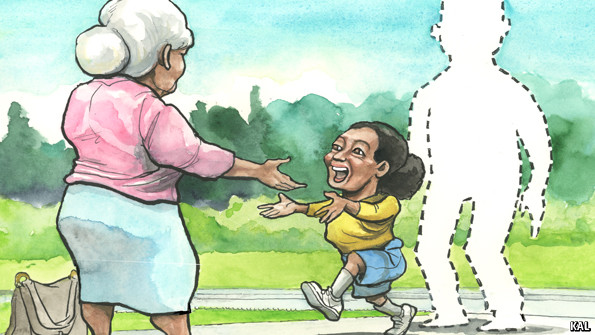BARACK OBAMA was raised by his grandparents for part of his childhood. He remembers his grandmother as being “tough as nails”. Clarence Thomas, a Supreme Court judge, was raised by his grandparents because his mother could not make ends meet. He called his grandfather “the greatest man I have ever known”. Grandparents have always reared children when need arose. Most have done it well. A few have done it badly—the late comedian Richard Pryor, who was raised by his grandmother in a brothel she owned, was constantly beaten.
What is new is that, as the nuclear family frays, grandparents are taking more and more of the strain. Of the 75m children in America, 5.5m live in households headed by grandparents, a number that has risen by almost a million since 2005, according to the Census bureau. Beware stereotypes. Child-rearing grandparents are disproportionately black, but in absolute terms most are white, live above the poverty line and own their own homes. When a parent loses a job or cannot pay the mortgage, many families move in with grandma. Sometimes, however, the parents have disappeared: an estimated 900,000 children are being raised solely by grandparents.
Pemberton Park is purpose-built for grandparents raising youngsters in so-called “skipped generation” families. Its publicly subsidised apartments are reserved for those over 55 or under 21. Like most retirement homes it is a matriarchy: of its 36 households, all but three are headed by women. The complex opened in 2011, joining about a dozen similar projects across America, from the Bronx to Arizona. More are expected.Pemberton Park, an apartment complex in Kansas City, Missouri, caters to such families. The hush of the retirement home hangs over its brightly lit corridors and snail-slow lifts. Yet there are signs of youth everywhere: Girl Scout notices in the activity room, pop-star posters on apartment walls. Local donors have dropped off food to feed growing bodies: sacks of apples, pallets of yogurts, gallons of fruit juice. There is a computer lab, a children’s library and, outside, a playground, regularly patrolled to keep drug dealers away. The complex has a part-time social worker, charged with everything from mediating school disputes to overseeing a sexual-abstinence programme for teenagers.
Some of the observed rise in grandparent-headed families is simply down to their becoming more visible, as informal arrangements of the past clash with modern red tape, notably when registering children at school or seeking medical treatment. But something is happening, and on a scale that is drawing policy responses. It is not just that public-housing authorities are building playgrounds outside retirement homes. To avoid long custody cases, more states are creating guardianship laws, allowing grandparents to register children with schools or doctors without formally severing ties with missing or hostile parents.
Visiting Pemberton Park inspires both hope and gloom. On a positive note, resident grandmothers describe tireless efforts to bring stability to the lives of their children’s children. Lois Powell, wheelchair-bound at 59, has been raising her teenage step-granddaughter since she was a baby. She is “really old-fashioned” with her, stressing the need to finish school. Rose Stigger, 61, twice went to court to win custody of her granddaughters, fearing for their welfare with an errant mother and a father (her son) in and out of prison. Miss Stigger longs for her girls to attend college, as she never did. Pemberton Park is a support group in bricks and mortar, she beams: the grandmothers “have each other’s backs”.
On a bleaker note, the grandmothers describe a society in bad shape. Miss Stigger has worked her whole life and still does. Coming generations may never know such stability. Too often, it is “babies having babies”, she says. That creates parents too young or poorly educated to land a job that pays enough to bring up a family: “Then they drop them off at Mom’s.”
Hang about, look out for Supergran
The grandmothers struggle with modern schoolwork (mathematics is a special trial), modern morals and sheer exhaustion. Absent parents drop in for disruptive, fleeting visits, flashing cash and shiny possessions. Most youngsters want to do Grandma proud, says Latoya Walker, Pemberton Park’s resident counsellor. But they also see her as “the person who nags all the time”.
Samuel McHenry, a legal-aid lawyer, has worked with grandparents for more than 20 years. He can list the crises that send them to his downtown office in Kansas City, anxiously seeking guardianship of a child. Perhaps one in ten cases involves a parent’s death. Those are simple, unless competing grandparents start fighting, sighs Mr McHenry, a gentle, world-weary sort. It is not unusual for military parents to grant temporary guardianship to grandparents when they are deployed. About a third of his casework involves parents jailed for drugs or too addicted to cope with raising children. Roughly half of the time, parents “just took off”. Here too drugs are usually suspected. Some big changes jump out: the grandparents in his office are getting much younger, with a median age in the late 40s now. More are repeat clients, seeking to take care of multiple babies by different adult children, four or five years apart. Fewer of these adult children ever marry.
Mr McHenry’s clients are poor, but he sees plenty of private lawyers at court, representing more affluent grandparents in similar straits. What all have in common is that they are trying to save their families, after earlier disasters.
That, perhaps, should nudge the onlooker towards wary optimism. Kansas City’s grandmothers inhabit a society under great strain. But they head families of amazing resilience, built on a faith in second chances buttressed by hard work. That is not nothing. Wish them luck, them and the children they are raising.

 Images from NASA's Curiosity rover on Mars
Images from NASA's Curiosity rover on Mars






























